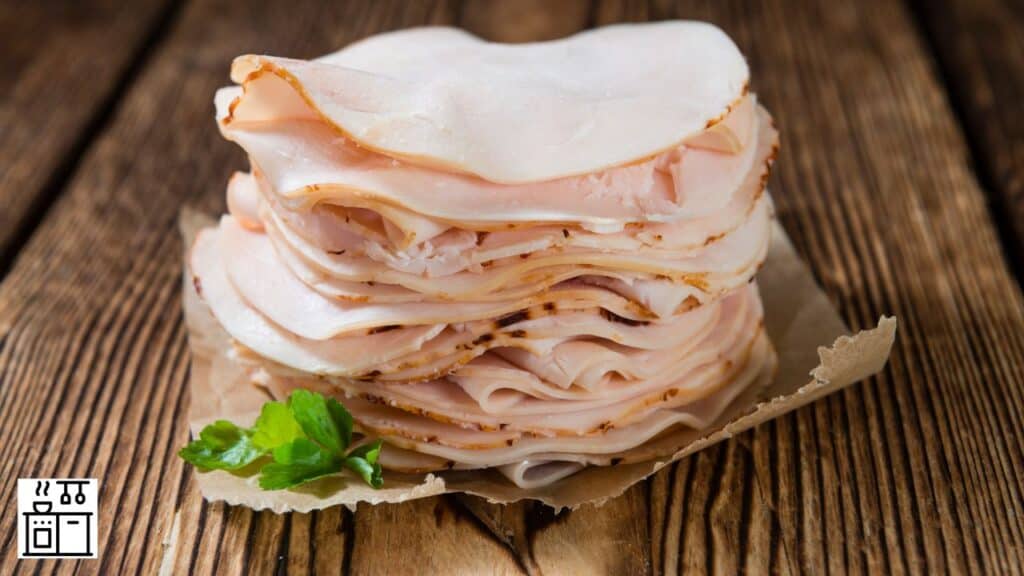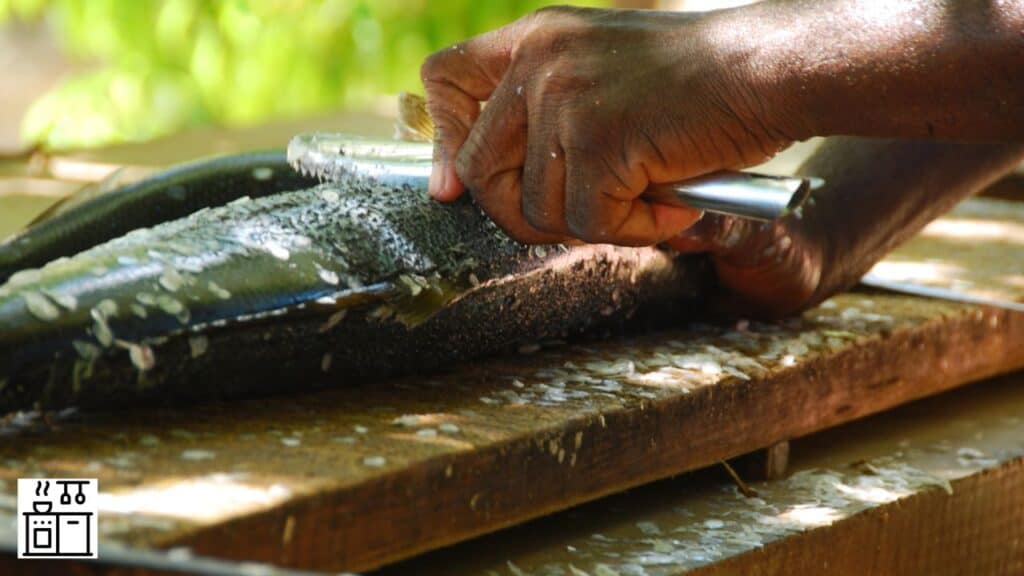You can easily identify a fillet knife by its distinct flexible blade and slender profile.
Traditional Japanese fillet knives curve upwards, but the blade of modern versions aren’t as curved.
These knives usually measure between six and eleven inches.
So, what is a fillet knife used for?
- The Main Use of A Fillet Knife
- 14 Different Ways to Use a Fillet Knife
- 1. Make Delicate Cuts Around Flesh and Bone
- 2. Remove Skin and Fat from Meat
- 3. Make Fish Fillets
- 4. Remove the Guts of Fish
- 5. Scale Fish
- 6. Debone Fish
- 7. Slice Chicken
- 8. Slice Cold Cuts of Luncheon Meat
- 9. Peel Fruits and Vegetables
- 10. Slice Fruits and Vegetables
- 11. Slit Chilies and Other Vegetables
- 12. Cut Orange Supremes
- 13. Slice Cheese
- 14. Remove the Pith of Fruits and Decorative Cutting
The Main Use of A Fillet Knife
As the name suggests, a fillet knife is used to fillet meat and fish. The design is specifically suitable for filleting fish without bruising the delicate meat.
However, making fish and meat fillets isn’t the only way to use this knife.
You can also use it for various other purposes.
Let’s find out what they are.
14 Different Ways to Use a Fillet Knife
Due to their unique shape and design, you can use fillet knives for any of the following purposes.
1. Make Delicate Cuts Around Flesh and Bone
The blade of a fillet knife is slender and serrated. It’s also very sharp, which makes it easy to cut through the meat.
Since the blade is slender, it has low drag and less friction. Hence, it can make clean cuts.
These characteristic features prove useful in cutting clean fish and meat fillets.
The sharp blade also increases the precision of a cut.
You can easily move the blade around bones and cut the flesh.
2. Remove Skin and Fat from Meat
Fillet knives are sharp and slender. The blade is flexible.
These factors make it easy to contour around the bones in a cut of meat.
So you can use a fillet knife to remove fat that sticks to the meat without affecting the meat.
In the same way, it’s also easy to cut through any skin that attaches to the meat using this knife.
The blade will neatly slide into the space where the skin meets flesh.
You can make a sharp cut and lift off the skin without wasting any meat.
3. Make Fish Fillets
Not all knives are suitable for cutting fish because it’s delicate.
Using heavy and thick knives can bruise their delicate flesh and make them look unappetizing.
A fillet knife, however, does the task perfectly.
The sharp and precise blade cuts through the meat without bruising it.
The slender blade has low friction, and hence it makes a neat cut.
You can easily slice the fish to any desired thickness and remove the cut portion.
Since the blade is flexible, it also adapts to different types of fish.
4. Remove the Guts of Fish
Removing the guts from a whole fish is a difficult task. You can use a fillet knife for it.
Use the sharp tip of the blade to make an incision along the length of the fish.
This will expose the internal organs, and you can remove them by slicing the area where they attach to the flesh.
The main benefit of using a fillet knife for gutting is that it does a clean job.
Thicker knives can make cutting difficult. They are also more difficult to clean up.
Meanwhile, thin knives can make a mess because they are too small to get the guts out with a single cut.
Fillet knives are just the right size for the job.
5. Scale Fish
Another difficult task when cleaning whole fish is descaling the skin.
Fortunately, you don’t need another tool for this task if you have a fillet knife.
The fillet knife’s blade has two sides.
The sharp and curved edge is for making incisions. This side of the blade isn’t suitable for removing the scales.
However, the blade also has a blunt side. It is long and straight.
This side is usually as long as the length of most common fish.
You can use this blunt side to remove the scales of the fish.
Just run the knife from top to bottom to get rid of the scales.
6. Debone Fish
Boning knives are specifically designed to remove bones from meat.
However, you can also use a fillet knife to remove fish bones.
Unlike other types of meat, fish bones break easily.
So it’s important to exert just enough pressure to remove the bones neatly.
This is possible with the fillet knife since it has a sharp and precise edge.
The flexible blade can slide between the bone and flesh and gently lift the bone off the flesh.
7. Slice Chicken

Certain parts of chicken meat are soft. Applying too much pressure will squeeze them.
However, you will have to cube or slice parts like chicken wings and breasts for various recipes.
In these situations, a fillet knife is the best tool.
The sharp and thin blade of the fillet knife guarantees neat and thin slices.
You can also use the sharp blade to trim any fat that attaches to the meat.
8. Slice Cold Cuts of Luncheon Meat
A fillet knife is an excellent tool for cutting thin slices of luncheon meat.
Salami and sausages are usually soft and tender.
You can use a fillet knife to neatly cut them into thin slices.
You can also use fillet knives to chop or cube tender cuts of meat with precision.
The benefit is that it creates neat edges that make the meat more presentable.
9. Peel Fruits and Vegetables
You can use the sharp and thin blade of a fillet knife to neatly peel the skin of carrots, plantains, cucumbers, potatoes, and other vegetables.
It’s also suitable for fruits like apples, avocados, lemons, and pears.
Since these vegetables and fruits have thin and soft peels, the knife can easily get between the skin and the flesh.
It will cut through the skin without causing any wastage.
However, this knife isn’t suitable for cutting the rind of vegetables like squash or pumpkin.
The blade can break under pressure.
So, limit its usage to vegetables with thin skin.
10. Slice Fruits and Vegetables
You can’t only peel but also slice or chop most fruits and vegetables with a fillet knife.
The sharp blade makes clean cuts that don’t damage the flesh of the fruit.
It also minimizes bruising, and the chopped pieces look presentable.
You can also use this knife to remove the peel of fruits like kiwis that attach tightly.
The sharp blade reduces wastage, and most of the fruit is saved for consumption.
The fillet knife is also good for cutting thin slices of eggplants, beets, potatoes, and other vegetables for deep-frying or decoration.
11. Slit Chilies and Other Vegetables
Many dishes require chilies to be slit, not chopped or sliced. The easiest way to do this is with a fillet knife.
The sharp and slender blade of a fillet knife makes it easy to slit the skin of chilies without cutting it all the way.
So the entire chilly can be added to a dish and taken out after cooking if required.
Similarly, you can use a fillet knife to cut vegetables like eggplants and peppers.
This makes it easy to add a spice rub or filling inside these vegetables for various recipes.
12. Cut Orange Supremes
Citrus fruits like oranges and lemons are filled with moisture. This makes it extremely difficult to cut.
Using the wrong knife will make the cutting messy. The fruits can also end up being pulverized.
However, you can cut neat orange supremes with a fillet knife.
The sharp and precise blade will easily slide into the flesh and make clean incisions.
This will allow you to cut thin slices without bruising the flesh.
13. Slice Cheese
Dedicated cheese knives are available for cutting different types of cheese.
However, if you don’t have a cheese knife, you can use a fillet knife. The blade will cut through semi-soft cheese.
You can also use it to slice small blocks of hard cheese.
However, avoid using the knife to cut hard blocks of cheese like Parmesan.
Applying too much pressure can break or bend the blade.
It may also not be suitable for soft cheese like Brie and Camembert because they stick mid-slice.
Related: Fillet vs. Boning Knife
14. Remove the Pith of Fruits and Decorative Cutting
The fillet knife is the perfect kitchen accessory to remove the pith from fruits without bruising the surrounding skin.
You can use it for mangoes, peaches, avocadoes, and other fruits and vegetables with bulky piths and seeds.
It’s also good for scraping out the seeds from cucumbers and zucchini without wasting any of the fleshy parts.
Apart from deseeding, you can also use a fillet knife to cut fruits in beautiful shapes for fruit platters.
With some practice, you can use this knife to make beautiful rosettes with apples, radishes, and other edible items.

